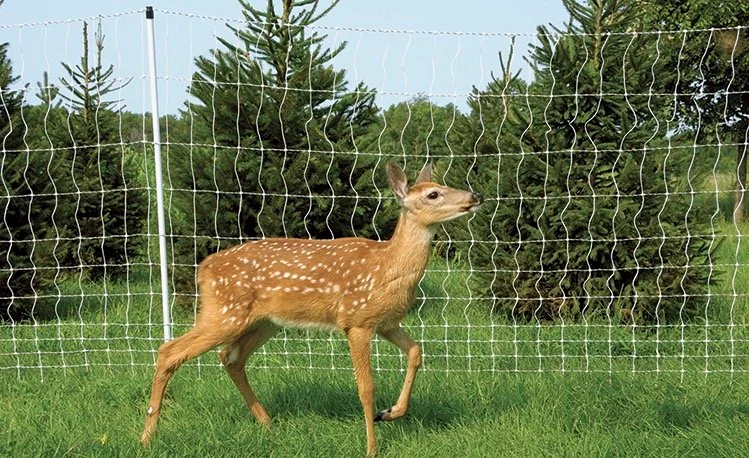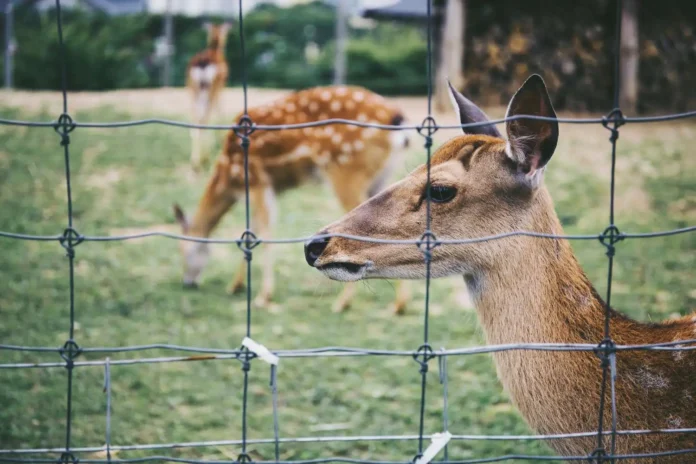Deer may seem like gentle creatures, but they can wreak havoc on gardens and landscapes. From trampling delicate flowers to feasting on crops, their presence often frustrates homeowners and gardeners alike. Installing a deer fence is one of the most effective ways to protect your property, but choosing the right height can be tricky. A wall that is too low won’t keep deer out, while a towering structure might disrupt the beauty of your outdoor space. Striking the perfect balance between functionality and aesthetics is essential to ensure your fence serves its purpose and complements your landscape. In this guide, we’ll explore how to choose the ideal height for a deer fence that blends practicality with visual appeal.
Why A Deer Fence Is Necessary
Deer may be beautiful to watch, but their impact on gardens, crops, and landscaping can be devastating. These animals are notorious for grazing on plants, stripping shrubs, and leaving trails of destruction in their wake. Beyond the aesthetic damage, deer can also pose safety concerns, such as attracting predators to your property or causing accidents on nearby roads. Dealing with these issues can feel like an endless battle for homeowners and gardeners. This is where deer fences come into play. A well-constructed fence is a reliable barrier, deterring deer from entering your property and protecting your greenery. By installing a deer fence, you safeguard your plants and create a secure environment where your landscaping efforts can thrive without constant worry.
Understanding Deer Behavior
To effectively deter deer from invading your garden or property, it’s essential to understand their behavior. Deer are remarkable jumpers, capable of leaping up to 8 feet in height. This agility allows them to easily clear shorter fences, making height a critical factor in keeping them out.
Several factors influence deer movement and their tendency to jump fences. Food scarcity is a significant driver, as deer will go to great lengths to access plants, fruits, or vegetables when natural resources are limited. Additionally, perceived threats in their environment, such as predators or human activity, can alter their movement patterns and make them more likely to seek refuge in fenced areas.
Considering these behavioral traits, you can design a fence that deters deer. The right height and structure not only address their physical abilities but also discourage them from attempting to enter your property altogether.
Recommended Fence Heights for Deer Protection

When it comes to deer fences, choosing the right height is crucial to protect your garden or property. A minimum fence height of 6 to 8 feet is typically sufficient for most residential gardens. Deer are less likely to jump over fences of this height unless they are particularly motivated or desperate.
However, for more significant properties or areas that experience persistent deer activity, taller fences ranging from 8 to 10 feet may be necessary. These fences provide extra security, especially in rural or wooded areas with higher deer populations.
An alternative option is to use slanted or angled fences. Adding a slant makes the wall more challenging for deer to navigate, as they prefer vertical barriers for jumping. This technique is beneficial for properties where height and visual deterrence are needed to keep deer at bay effectively.
How Tall Of Fence To Keep Deer Out
To keep deer out, the ideal fence height ranges from 6 to 8 feet. Deer can jump up to 8 feet, so a fence shorter than this may not be effective. For areas with high deer activity, consider a taller fence, up to 10 feet. Slanted fences or angled designs can also add extra deterrence. Always aim for a balance between height and aesthetics to blend functionality with your landscape.
Optimal Height for a Deer Fence
Selecting the right fence height is critical for balancing effectiveness and visual appeal when keeping deer out. The generally recommended height for a deer fence is between 6 to 8 feet. This range is sufficient for deterring most deer, as their jumping ability is tested at heights beyond 6 feet.
Shorter fences, under 6 feet, may blend seamlessly into the landscape and enhance aesthetic appeal. However, they often fall short in functionality, especially in areas with frequent deer activity. Deer can easily leap over these shorter barriers, making them less effective for protecting gardens and crops.
On the other hand, taller fences, measuring 8 feet or more, are highly effective at keeping deer out. These heights are particularly recommended for properties with persistent deer issues. However, such fences can appear intrusive or disrupt the visual harmony of the surroundings. Striking the right balance between height, functionality, and aesthetics is key to designing a deer fence that meets your needs.
Alternative Solutions to Complement Fences
While fences are an effective solution for keeping deer out, combining them with alternative deterrents can enhance protection and reduce the need for excessively tall or obtrusive barriers. One popular option is deer repellents, which emit scents or tastes that deer dislike. These can be applied to plants and shrubs, acting as an extra layer of defense.
Motion-activated sprinklers are another innovative solution. These devices detect movement and spray water, startling deer and discouraging them from venturing further. Similarly, planting deer-resistant plants around the perimeter of your garden can act as a natural deterrent. Options such as lavender, daffodils, or marigolds repel deer and add beauty to your landscape.
Choose Professional Installation
When installing a deer fence, professional installation ensures both effectiveness and durability. While DIY projects might seem cost-effective, they often come with challenges that can compromise the fence’s performance and longevity.
Why Opt for Professional Installation?
- Expertise and Experience: Fencing professionals understand the nuances of selecting the right materials, ensuring proper placement, and creating an efficient design. They can assess your property’s layout and install a fence that addresses issues like uneven terrain or areas with high deer activity.
- Long-Term Durability: Professionals ensure that your fence is installed correctly, with proper anchoring and secure posts, minimizing the risk of sagging or instability over time. Proper installation can save you from costly repairs in the future.
- Cost-Effectiveness in the Long Run: While professional installation might seem more expensive upfront, it can save you money in the long term by preventing mistakes, reducing the risk of deer getting past the fence, and ensuring a longer-lasting solution. DIY mistakes, on the other hand, might lead to additional costs for repairs or even the need for a complete fence replacement.
- Design and Aesthetic Integration: Professionals can help you choose materials and design elements that complement your landscape. Whether you prefer a natural wood fence or a sleek metal barrier, experts can recommend the best options to meet both functional and aesthetic goals.
The Best Fence Height for Different Uses
Three to Four Feet:
Ideal for decorative purposes or areas with minimal deer activity. While it may deter smaller wildlife, it’s ineffective against deer, as they can easily jump over it.
Five Feet:
A slightly higher option for low-deer-pressure areas. It offers some protection but is still not tall enough to stop determined deer.
Six Feet:
Suitable for gardens with moderate deer activity. While it’s more functional, some agile deer may still leap over it, especially when food is scarce.
Seven to Eight Feet:
A reliable height for most properties. This range effectively deters deer and balances functionality with aesthetics, making it a popular choice.
Ten to Twelve Feet:
Best for areas with high deer populations or persistent issues. These fences provide maximum protection but may require professional installation and be visually intrusive.
Balancing Functionality and Aesthetics
Material Choices
When selecting materials for your deer fence, consider both durability and appearance. The right material can help maintain the fence’s functionality while blending seamlessly with your landscape.
- Wood: Offers a natural, rustic look that complements garden designs. It is strong and durable but may require more maintenance over time.
- Metal: Provides a sleek, modern appearance, especially in industrial or contemporary gardens. It’s durable and low-maintenance but can sometimes be more noticeable.
- Vinyl: A low-maintenance option that comes in various styles and colors. It can mimic wood or metal and is weather-resistant, making it ideal for long-term use.
Design Options
Adding decorative elements to your deer fence can enhance its visual appeal without compromising its purpose.
- Lattice Panels or Trellises: These add elegance and can support climbing plants, further blending the fence into the landscape.
- Decorative Ironwork: For a more stylish touch, decorative metal elements can turn a functional fence into an attractive garden feature.
Natural Barriers
Pair your deer fence with hedges or shrubs to achieve a more organic look. Plants like holly or boxwood can mask the fence and offer additional deterrents. This natural combination enhances both the fence’s effectiveness and the beauty of your landscape.
Summary
In conclusion, choosing the right fence height to keep deer out is a careful balance between functionality and aesthetics. A fence between 6 to 8 feet tall is typically sufficient to deter most deer, with taller options up to 10 feet offering added security for areas with frequent deer activity. Alternatives like repellents, motion-activated sprinklers, and deer-resistant plants can further enhance protection without needing excessively tall fences. By opting for professional installation and selecting the right materials, you can ensure a durable, effective solution that complements your landscape and protects your garden for years.
Read Also: How To Make Raised Garden Bed Cheap



